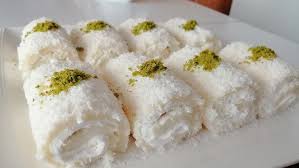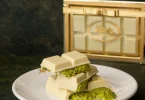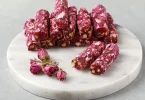Turkish delight, or “lokum,” is a beloved confection with a rich history and a flavor profile that has delighted generations. Among the many variations of Turkish delight, Pasha Turkish Delight stands out as a luxurious and refined version, often associated with royalty and opulence. In this blog post, we’ll explore the history, ingredients, and unique characteristics of Pasha Turkish Delight, as well as why it remains a symbol of indulgence.
What is Pasha Turkish Delight?
Pasha Turkish Delight is a premium version of the traditional lokum. While regular Turkish delight comes in various flavors like rose, lemon, and pomegranate, Pasha Turkish Delight takes it to the next level with rich fillings and coatings. These can include:
Nuts: Pistachios, hazelnuts, or walnuts.
Creams: Milk-based fillings for a velvety texture.
Exotic Flavors: Saffron, cinnamon, or mastic for a touch of luxury.
Toppings: Coconut flakes, powdered sugar, or even edible gold.
Its name, “Pasha,” refers to a high-ranking title in the Ottoman Empire, symbolizing grandeur and sophistication.
A Brief History of Turkish Delight
The origins of Turkish delight date back to the Ottoman Empire in the 15th century. Lokum, as it is known in Turkish, became a favorite sweet among the sultans and their courts. The confection was prized for its delicate texture and ability to carry unique flavors.
By the 18th century, Turkish delight gained international fame when it was introduced to Europe. It quickly became a popular treat, often gifted as a token of love or hospitality. The luxurious Pasha variation emerged as a way to elevate the traditional lokum into a dessert fit for royalty.
Ingredients of Pasha Turkish Delight
The ingredients of Pasha Turkish Delight differ from standard lokum due to its added richness. Here’s what typically goes into this decadent treat:
Base:
Sugar
Water
Starch (often cornstarch)
Citric acid or cream of tartar
Flavorings:
Rosewater, orange blossom water, or other aromatic essences.
Unique additions like saffron or mastic.
Fillings:
Whole or chopped nuts (pistachios, almonds, or hazelnuts).
Creamy milk-based mixtures.
Coatings:
Finely shredded coconut, cocoa powder, or powdered sugar.
Optional Luxury Additions:
Edible gold flakes or decorative designs.
How is Pasha Turkish Delight Made?
The process of making Pasha Turkish Delight is both an art and a science. Here’s how it’s traditionally prepared:
Create the Base: Sugar, water, and starch are cooked together until the mixture thickens into a jelly-like consistency. This is the foundation of Turkish delight.
Incorporate Flavorings: Rosewater or other essences are added to infuse the base with its signature aroma.
Add Fillings: For Pasha varieties, the mixture is layered or rolled with nuts, creams, or dried fruits.
Shape and Coat: Once set, the lokum is cut into small cubes or logs and coated with powdered sugar, coconut, or other toppings to prevent sticking and enhance flavor.
Pack with Care: Pasha Turkish Delight is often packaged in ornate boxes, reflecting its premium quality.
Why is Pasha Turkish Delight Special?
Pasha Turkish Delight isn’t just a dessert; it’s an experience. Its luxurious ingredients and intricate preparation make it a symbol of celebration and indulgence. Here’s why it stands out:
Rich Flavors: The addition of nuts, creams, and exotic spices elevates the taste to a whole new level.
Perfect for Gifting: The ornate presentation makes it a perfect gift for special occasions.
Cultural Significance: It embodies the opulence of Ottoman culture, making it more than just a sweet treat.
Versatility: It pairs beautifully with Turkish coffee or tea, adding an extra touch of elegance to any occasion.
Health Benefits of Pasha Turkish Delight
While it is undoubtedly a treat, Pasha Turkish Delight also offers some surprising health benefits due to its natural ingredients:
Energy Boost: The sugar content provides a quick source of energy.
Rich in Nutrients: Nuts like pistachios and hazelnuts are packed with healthy fats, protein, and vitamins.
Gluten-Free: Made with starch instead of flour, it is naturally gluten-free, making it a suitable option for those with gluten sensitivities.
How to Serve and Enjoy Pasha Turkish Delight
Pasha Turkish Delight is best enjoyed fresh and in good company. Here are some serving suggestions:
With Coffee or Tea: Pair it with a traditional Turkish coffee or a cup of herbal tea for a perfect afternoon break.
As a Dessert: Serve it as a dessert at the end of a meal, accompanied by a platter of fruits and nuts.
For Special Occasions: Use it as a centerpiece for festive occasions like weddings, holidays, or family gatherings.
Where to Find Pasha Turkish Delight
Authentic Pasha Turkish Delight is best sourced from specialized Turkish confectionery shops or artisan producers. If you’re unable to find it locally, many online retailers ship high-quality Turkish delight worldwide. Look for brands that emphasize natural ingredients and traditional methods to ensure the best quality.
Final Thoughts
Pasha Turkish Delight is more than just a confection; it’s a symbol of elegance, culture, and tradition. Its rich flavors, luxurious presentation, and cultural heritage make it a treat that transcends time. Whether you’re indulging yourself or gifting it to a loved one, Pasha Turkish Delight is sure to leave a lasting impression.








